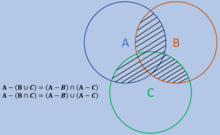
Back قوانين دي مورغان Arabic De Morqan qanunları Azerbaijani Законы Дэ Моргана BE-X-OLD Закони на Де Морган Bulgarian Lleis de De Morgan Catalan De Morganovy zákony Czech Deddfau De Morgan Welsh De Morgans love Danish De-morgansche Gesetze German Τύποι Ντε Μόργκαν Greek

In propositional logic and Boolean algebra, De Morgan's laws,[1][2][3] also known as De Morgan's theorem,[4] are a pair of transformation rules that are both valid rules of inference. They are named after Augustus De Morgan, a 19th-century British mathematician. The rules allow the expression of conjunctions and disjunctions purely in terms of each other via negation.
The rules can be expressed in English as:
- The negation of a disjunction is the conjunction of the negations
- The negation of a conjunction is the disjunction of the negations
or
- The complement of the union of two sets is the same as the intersection of their complements
- The complement of the intersection of two sets is the same as the union of their complements
or
- not (A or B) = (not A) and (not B)
- not (A and B) = (not A) or (not B)
where "A or B" is an "inclusive or" meaning at least one of A or B rather than an "exclusive or" that means exactly one of A or B.
In set theory and Boolean algebra, these are written formally as
where
- and are sets,
- is the complement of ,
- is the intersection, and
- is the union.

In formal language, the rules are written as
and
where
- P and Q are propositions,
- is the negation logic operator (NOT),
- is the conjunction logic operator (AND),
- is the disjunction logic operator (OR),
- is a metalogical symbol meaning "can be replaced in a logical proof with", often read as "if and only if". For any combination of true/false values for P and Q, the left and right sides of the arrow will hold the same truth value after evaluation.

Another form of De Morgan's law is the following as seen in the right figure.
Applications of the rules include simplification of logical expressions in computer programs and digital circuit designs. De Morgan's laws are an example of a more general concept of mathematical duality.
- ^ Copi, Irving M.; Cohen, Carl; McMahon, Kenneth (2016). Introduction to Logic. doi:10.4324/9781315510897. ISBN 9781315510880.
- ^ Hurley, Patrick J. (2015), A Concise Introduction to Logic (12th ed.), Cengage Learning, ISBN 978-1-285-19654-1
- ^ Moore, Brooke Noel (2012). Critical thinking. Richard Parker (10th ed.). New York: McGraw-Hill. ISBN 978-0-07-803828-0. OCLC 689858599.
- ^ DeMorgan's [sic] Theorem
- ^ Kashef, Arman. (2023), In Quest of Univeral Logic: A brief overview of formal logic's evolution, doi:10.13140/RG.2.2.24043.82724/1
© MMXXIII Rich X Search. We shall prevail. All rights reserved. Rich X Search













